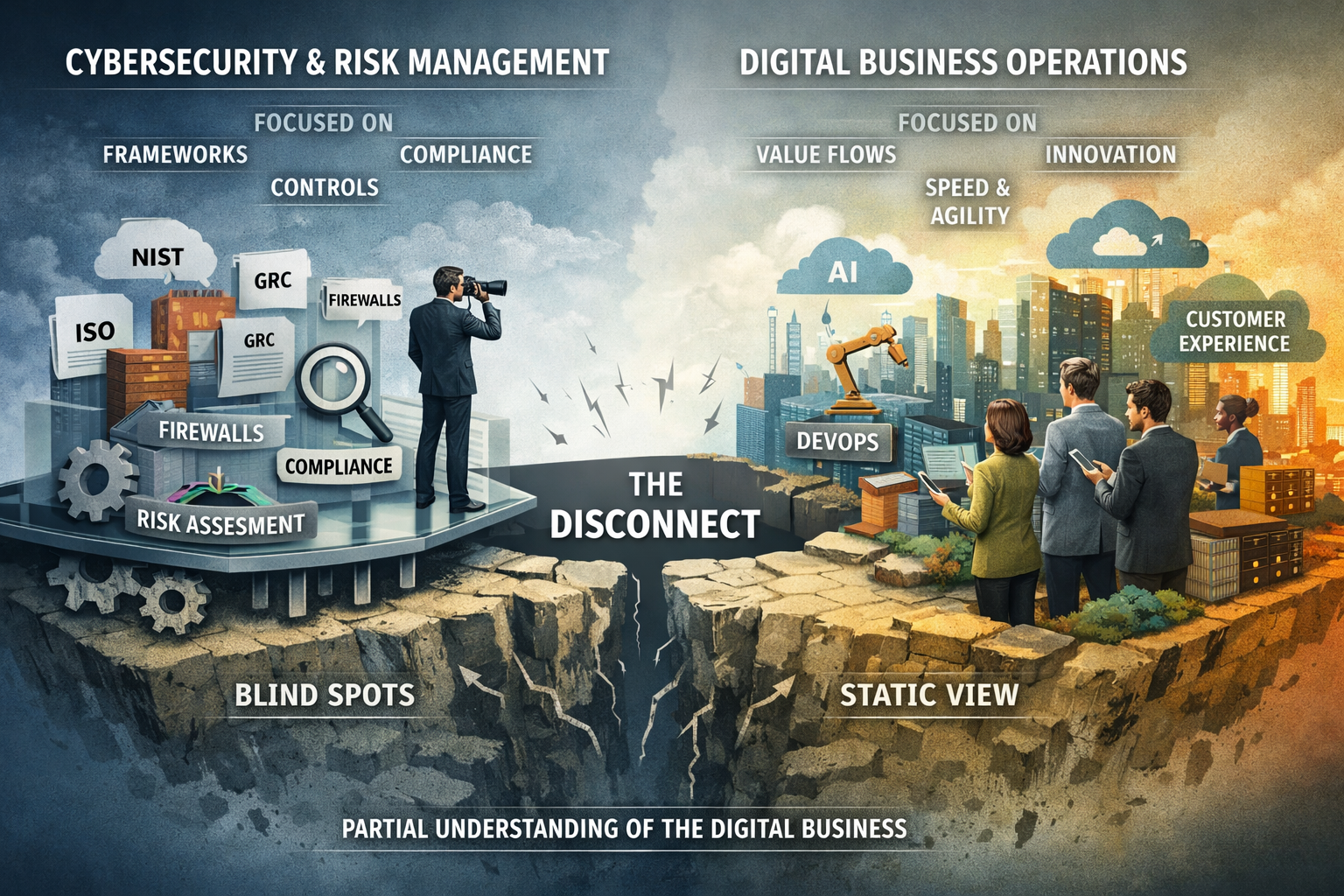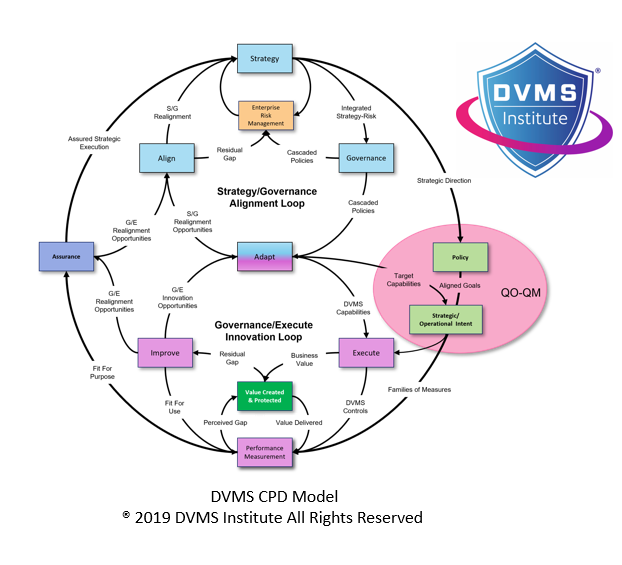How the DVMS 3D Knowledge Model Delivers on the Promise of Dynamic Governance
David Nichols – Co-Founder and Executive Director of the DVMS Institute
In today’s digital-first world, the promise of Governance, Resilience, and Assurance (GRA) is clear: organizations must actively manage value creation in real time, embed resilience into their core operations, and continuously ensure the achievement of strategic objectives.
However, many leaders have found that scaling GRA across a complex and dynamic organization is far from straightforward.
This is where the Digital Value Management System (DVMS)—with its innovative 3D Knowledge Model—comes into play. It offers a practical and structured approach to align workflow, communication, and innovation at the strategy, governance, and operational levels. This enables GRA to transition from theoretical concepts to sustainable practices.
In this article, we will explore how the 3D Knowledge Model simplifies the challenges of scaling GRA and why organizations that adopt it are more likely to thrive in chaotic environments.
Understanding the Challenge: GRA in a Complex World
GRA isn’t just about improving governance, resilience, and assurance—it’s about doing them dynamically, at the speed and scale of modern disruption.
Unfortunately, many organizations find themselves trapped:
- Strategy teams operate with great intentions but are disconnected from operational reality.
- Governance functions enforce static policies that can’t keep pace with change.
- Operational teams innovate, protect, and deliver value — but often without timely visibility into evolving strategic priorities or risk thresholds.
The result? Governance lags behind action. Resilience is reactive, not proactive. Assurance becomes retrospective paperwork rather than real-time validation.
Without a clear way to dynamically connect strategy, governance, and operations, organizations struggle to deliver on GRA’s promise.
Enter the DVMS 3D Knowledge Model
The DVMS 3D Knowledge Model was designed precisely to solve this problem.
Rather than treating strategy, governance, and operations as separate silos, the model recognizes that GRA depends on how knowledge flows across and between these levels — not just once, but continuously.
The three dimensions of the model are:
- Strategy Knowledge — Clarifying strategic policies, objectives, risk appetites, and value priorities.
- Governance Knowledge — Translating strategy into actionable, dynamic governance mechanisms that evolve with operational feedback.
- Operational Knowledge — Capturing real-world execution realities, risk signals, and performance data to inform governance and adjust strategy.
By organizing knowledge this way — and flowing it continuously — the DVMS 3D Knowledge Model creates the connective tissue that GRA needs to function dynamically.
The Flow of Work: From Strategy to Execution and Back Again
In a DVMS-enabled organization, workflow isn’t a one-way street. It’s a dynamic cycle fueled by the 3D Knowledge Model.
- Strategy teams define digital business value outcomes, risk appetite, and strategic policies.
- Governance teams interpret these into adaptive governance controls embedded directly into operational workflows (not just static checklists).
- Operational teams create, protect, and deliver value, continuously feeding real-world insights into governance.
The result? Governance teams use operational data to adjust policies and controls in near real time, while strategy teams refine objectives based on validated operational realities and shifting external conditions. This dynamic, feedback-driven work model keeps GRA alive. It enables real-time governance, proactive resilience, and continuous assurance of outcomes—all tied directly to digital value.
Without the 3D Knowledge Model structuring how knowledge flows, organizations either lose connection across these levels or drown in complexity.
Communication: The Lifeblood of Dynamic GRA
Communication often breaks down between strategic, governance, and operational layers because there’s no common language or shared structure.
The DVMS 3D Knowledge Model fixes this by:
- Structuring information consistently across all three levels.
- Providing common templates for strategic intents, risk thresholds, control objectives, operational activities, and assurance results.
- Standardizing feedback loops so insights can move up, down, and across without getting distorted.
At the strategy level, leadership communicates intent clearly, not just what outcomes are desired but also what risks are acceptable and what tradeoffs are permissible. At the governance level, risk teams and governance owners translate strategic policies into dynamic operational controls and decision criteria that are directly understandable by teams. At the operational level, teams communicate execution realities (threats, opportunities, bottlenecks) in formats that map cleanly back into governance and strategy adjustments.
The result? Seamless, aligned communication that allows GRA to operate at the speed of digital business, not the speed of quarterly reviews.
Innovation: Building Resilience and Agility by Design
Many organizations treat resilience and innovation as separate or conflicting pursuits. However, in the DVMS model, innovation and resilience are two sides of the same coin.
The 3D Knowledge Model fosters innovation at each level:
- Strategic innovation: Leaders can safely experiment with new value propositions because the model ensures operational guardrails and feedback mechanisms are in place.
- Governance innovation: Risk teams can adapt controls dynamically, using real-time assurance data, without waiting for major governance overhauls.
- Operational innovation: Teams are empowered to innovate how they create, protect, and deliver value because governance is adaptive, not rigid.
Because resilience is embedded into the operational fabric (not bolted on afterward), organizations can innovate faster while remaining resilient. Risk isn’t an afterthought — it’s a strategic enabler.
GRA Outcomes Delivered Through the 3D Knowledge Model
By structuring work, communication, and innovation across the strategy, governance, and operational layers, the 3D Knowledge Model enables organizations to realize the full promise of GRA:
GRA Domain Enabled By 3D Knowledge Model
Governance Dynamic, embedded, real-time governance adjustments
Resilience Proactive design into operations; continuous adaptation
Assurance Continuous validation of strategic policy achievement
Governance is no longer a static policy shelf, resilience is no longer an emergency plan, and assurance is no longer a backward-looking audit. GRA becomes a living, breathing system that evolves in lockstep with operational reality and strategic ambition.
Bottom Line: Scaling GRA Doesn’t Have to Be Mysterious
The truth is, it’s not complexity that’s the problem — it’s unstructured complexity.
The DVMS 3D Knowledge Model demystifies scaling GRA.
It provides structure without rigidity, enabling speed without chaos. It connects strategy, governance, and operations through a living knowledge flow that makes dynamic governance, resilience, and assurance real.
If you want your organization to thrive at the edge of chaos — to govern digital value dynamically, to build resilience by design, and to assure outcomes at scale —the DVMS 3D Knowledge Model is not just helpful. It’s essential.
About the Author

Dave is the Executive Director of the DVMS Institute.
Dave spent his “formative years” on US Navy submarines. There, he learned complex systems, functioning in high-performance teams, and what it takes to be an exceptional leader. He took those skills into civilian life and built a successful career leading high-performance teams in software development and information service delivery.
The DVMS Institute’s NIST Cybersecurity Framework Digital Value Management System® certified training programs teach enterprises of any size, scale, or complexity the skills to build a Holistic, Adaptive, and Culture-Powered Enterprise Cyber Resilience System and Team capable of proactively identifying and mitigating the systemic risks that impact digital business operations.
Enterprises can become resilient by embedding systemic risk management into strategic decision-making and aligning it with adaptive Governance, Resilience, Assurance, and Culture.
This unique and innovative approach to Cyber Resilience also enables enterprises to be compliant with any regulatory (SEC , UK, DORA, NIS2, SAMA, SOCI, IMO, MCU) or maturity model program (HITRUST, CMMC, C2M2, SCF).
® DVMS Institute 2024 All Rights Reserved




